Obituaries-We Mourn the Passing….
We can’t help but think that those of us engaged in the pop-up world are youthful and will forever be so. Alas, that is not the case. On these pages will be a salute to those recently departed and those who have left us a while ago but have earned the kudos of their obituaries. They have all contributed greatly to this magical world.
Peter Larkin, 93, died December 16, 2019. Peter is mostly unknown to Movable Book Society members, but not to the Popuplady. Through some round-about way I got to meet him to ‘help’ him produce a pop-up book of his burlesque designs. You should know Mr. Larkin was a four-time Tony award winner, outstanding in his field and quite an artist. His Tonys were for the set design of the Broadway shows, Peter Pan, No Time for Sargeants, and Teahouse of the August Moon and several well-known films. This was no ordinary artist. We met in Bridgehampton, NY where he lived and I had mounted an exhibit at the South Fork Natural History Museum. He brought his mock-up for a burlesque dancer that he wanted to produce as a pop-up book. What a delight to see this aging artist looking to learn something new to make his art come alive. That I ultimately was not able to help him was a shame. He deserved another time in the spotlight. I did video his mock up. https://nyti.ms/2PsETad
The Popuplady and the Movable Book Society mourn the passing, on September 11, 2015, of our esteemed and beloved pop-up book historian, Theo Gielen. Theo generously shared his knowledge in Utrecht, Netherlands where he lived and in the pages of Movable Stationery, the quarterly newsletter of the Movable Book Society. (click here for back issues) Readers looked forward to his lengthy, detailed, and erudite articles on many aspects of pop-up and movable books. His knowledge of 15 languages allowed us access to information most of us would never discover.
Theo’s enthusiasm for pop-up books brought him to the USA as a keynote speaker at MBS’ Washington, D.C.
Theo Gielen (1946-2015)
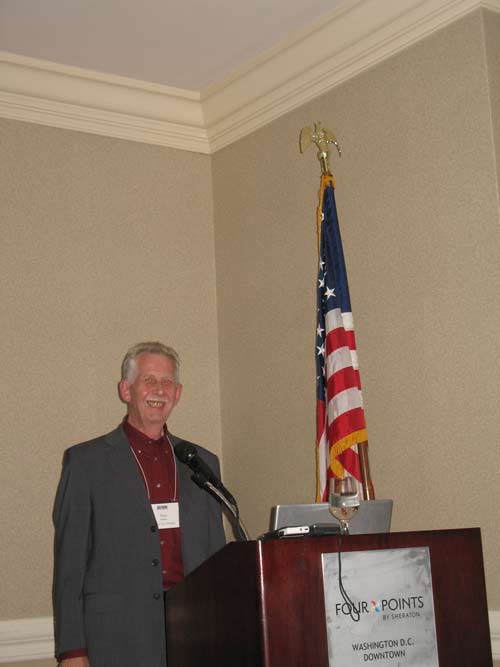
Conference in 2008, calling his talk, El Pintor or The Joys of Researching Movable, Novelty, and Pop-up Books. While not a “jokester,” he enjoyed telling us that the anagram for his name is Into Glee, eh? We were astounded to hear from our mild-mannered speaker that due to his dissident leanings, he was barred from visiting the USA. Theo concluded by encouraging us to “go into the stories [and history] behind our books,” pop-up books. Reflecting on his own experience, I said we would find “a deep satisfaction” in doing so.
On his visit to the US, Theo also took the time to visit The Popuplady’s library. He was so excited to visit that he forgot on the train the bouquet of flowers he had brought for me. Such a gentleman! Oh, the knowledge he shared about my collection answering so many questions and illuminating the material with his insights and knowledge. We maintained a robust correspondence via email sharing our findings and having a “friendly rivalry” as to who could find the most obscure movable book.
Theo was working on a history of pop-up books doubling his efforts after his diagnosis and hospitalizations. His work is unfinished and we can only hope it can be published so that his legacy will continue.
Farewell, Dear Friend.
The Popuplady
From SGKJ Newsletter: translated by Kees Moerbeek, Kyle Olmon-editor:
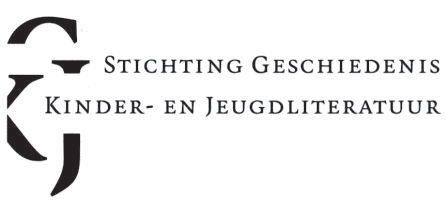
News Bulletin 5
September 14, 2015 by Jeannette Kok (jeannettekok@upcmail.com)
In memoriam Theo Gielen (1946 – 2015)
On Friday, September 11th, Theo Gielen passed away. His health had
been deteriorating in recent years and the latest complications proved
too much for him. Theo Gielen has meant a lot to the SGKJ.
In 2008, he received the Hieronymus van Alphen prize. On this occasion
Frits Booy wrote an ode in the style of Van Alphen (an 18th century Dutch poet) which mention Theo’s beloved children’s book topics were praised: Struwwelpeter, movable books and, the Dutch publisher, I. de Haan.
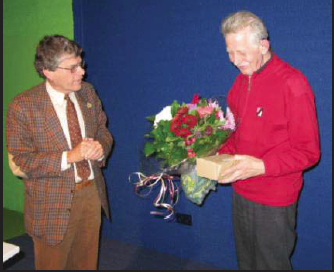
In addition to his research on Struwwelpeter books, he developed a huge
interest in 19th-century commercial picture books. For many years he
researched the history of El Pintor and contributed some of his findings
in De Verbeelders by Saskia de Bodt. Unfortunately, he was not given
enough time to finalize his book about this subject.
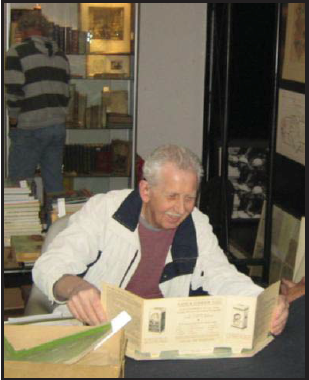
Theo had an expansive knowledge of the book business. He made many
students enthusiastic about books as a teacher of Children’s and Young Adult Literature.
He worked in Utrecht at a leftist bookstore called “De Rooie Rat” (The
Red Rat) and in later years at the bookstore of the Centraal Museum in
Utrecht. In 1997, he was one of the organizers of a major exhibition
of pop-up books at the Frans Hals Museum in Haarlem.
Theo was recognized and praised internationally and had many foreign contacts.
In Germany he was the authority onStruwwelpeter and in America he
was an expert on pop-up books. Some years ago, he was invited by the
Movable Book Society to present a keynote speech for fans of pop-up books.
He published many articles on movable books in the Movable Stationary, in
Leesgoed, a Dutch magazine on literature, and in Aus dem Antiquariat .He
published about Struwwelpeter and related books in Tot Volle Wasdom
(2000), in Boekenwereld; and commercial picture books in Prentenboeken:
ideologie en illustratie 1890-1950 by Saskia de Bodt and Jeroen Kapelle. He
also wrote about El Pintor in De Verbeelders. Theo gave various lectures for
students of Saskia de Bodt on movable and three-dimensional illustrated
children’s books and the work of El Pintor.
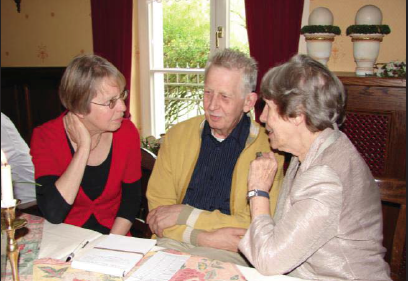
Theo carefully studied many of the auction catalogs and gave regular
suggestions on books that had potential for the KB or Koninklijke
Bibliotheek (Royal Library in The Hague) collection. For example, the KB became the owner of the first Dutch moveable book De nieuwe rijschool, which he wrote about in
De Boekenwereld. We would have liked a lot more publications from Theo.
Many collectors and researchers have been able to benefit from his extensive
knowledge, which he was gladly willing to share. Theo was also critical;
he never trusted other’s sources; he preferred to research things himself to
make sure the information was correct. He was a source of information for
me and others, especially when it came to dating children’s books or writing
a blog.
Since September 2002 we worked together on the Berichten uit de wereld van het oude kinderboek, starting from number 35 up to number 84, which was issued in September 2015. We collaborated for thirteen years; in the last few years a few times from a hospital room. It was never boring. Theo’s vast knowledge and network resulted in solid work. His humor and playful perspective helped make him a great writer and editor.
Here he is thinking deeply about a plan for the magazine.
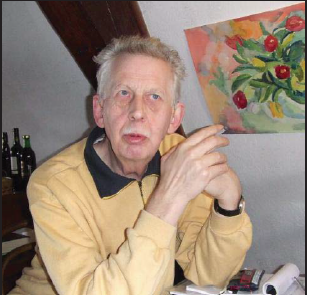
The photos below show Theo during a visit to Twickel at the invitation of
Christine Sinnighe Damsté to view a collection of movable books.
That was enjoyable.
We will miss him dearly, Jeannette Kok
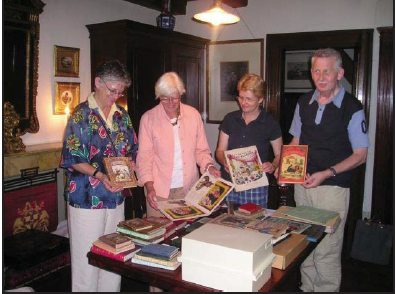

Chuck Murphy, paper engineer, has died.YouTube-Murphy’s One to Ten There will be a tribute at the Philadelphia, PA conference. Also, see the write up in Movable Stationery, August 2014 edition.
Dennis K. Meyer died in July, 2014. He had contributed art and paper engineering to some of the most classic pop-ups, including many of Nick Bantock’s books.
Maurice Sendak, 1928-2012

Robert Sabuda, Ann Montanaro, and The Popuplady with Sendak at the Brooklyn Pops Up Gala, Brooklyn Public Libary, January, 2001
We were the lucky ones who met and worked with Maurice. He generously gave his artwork to the Brooklyn Pops Up catalog, now in it’s 5th printing. Maurice died today, May 8, 2012, leaving behind a treasure trove of books, illustrations, and the joy he gave us all with his work. RIP, Dear Friend.
Read and hear more of his life in his own words: New York Times obituary, NPR obituary, NPR’s Terry Gross interviews Sendak. Listen with joy to Stephen Colbert’s televised interviews in 2 parts. PART 1; PART 2
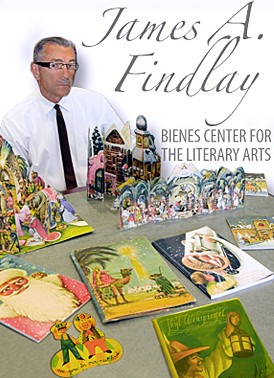
James A. Findlay (1943 – 2010)
[from Miami Herald] James Findlay, 67, passed away October 5, 2010 in Miami. An exceptional art librarian and collector, Jim was known nationally for his work on the New Deal. His career took him from MOMA, to RISD and then to the Wolfsonian-FIU where he was Chief Librarian. He retired from the Bienes Museum of the Modern Book, where as Director he developed the collection, curated exhibitions, published bibliographies and award-winning catalogues. He also instituted the Florida Artists’ Book Prize. A graduate of Wayne State and UCLA, he served in the Peace Corps in the Dominican Republic from 1966 – 1969. Jim is survived by Rafael Rodriguez, his partner of 24 years. Donations can be made to: Broward Public Library Foundation, In Memory of Jim Findlay, 100 S. Andrews Avenue, Fort Lauderdale, FL 33301
Jim was a consummate librarian and reseracher and curator. Moreaver, he was enthusiastic about pop-up and movable books. It was my extreme pleasure to work with him staging the very successful exhibition, Pop-ups, Illustrated Books, and Graphic Designs of Czech Artist and Paper Engineer, Vojtěch Kubašta (1914-1992) and the award-winning pop-up catalog produced with it. Jim’s other exhibitions on Robert Sabuda and the collection of Geraldine Lebowitz shed more light on paper engineering and collecting. His many contributions deserve great praise. He will be missed.
Obituary from the Wolfsonian Library [FLA]
A Memorial Plaque as a tribute to Jim Findlay at the Wolfsonian
Bruce Baker (1942-2009)
Those of us who pride ourselves on trying to get the complete set of Hallmark pop-up books from the ’70s are very familiar with the name Bruce Baker. His bibliography is extensive.
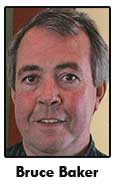
[from Westvalley View, Ariz] Robert “Bruce” Baker, 67, of Litchfield Park died from cancer Jan. 9, 2009. Mr. Baker was born in Rochester, Minn. He received an associate’s degree from the University of Minnesota and a bachelor’s degree from then St. Cloud State College. He worked for Hallmark Cards in Kansas City for 36 years as a paper mechanical engineer, designer of cards and a major contributor to a line of pop up books and children’s books. He retired in 2001. He was a member of Watercolor USA. He is survived by his wife, JoAnn; three sons, Paxton of Cornville, Robert of Lithia, Fla., and Thomas “Pete” of Sugar Hill, Ga.; one stepson, Brendan Meyer of White Bear Lake, Minn.; his mother, Enid; one sister, Turner Broll of Wilmington, Del.; one brother, George S. “Bucky” of Bozeman, Mont.; and numerous grandchildren. Services were private.
[from Hardcastle Gallery, 5714 Kennett Pike, Centreville, DE]
Bruce created a wide variety ofwatercolor paintings in the early years of his Hallmark career. He marketed his paintings through various art shows. During this period he received many awards for his watercolors (see attached list). Later as his career at Hallmark became more demanding, he ceased to enter into art shows and only sold his paintings to private individuals. He was commissioned for numerous paintings, both watercolor and oils. Upon retirement Bruce moved to Litchfield Park , Arizona and is looking forward to a fresh new career as a full time painter of oils and watercolors. Artists Statement “I try to capture in my paintings the varying moods of nature, from memories of the past and surroundings of the present.”
[from Movable Stationery vol.18, no.4]
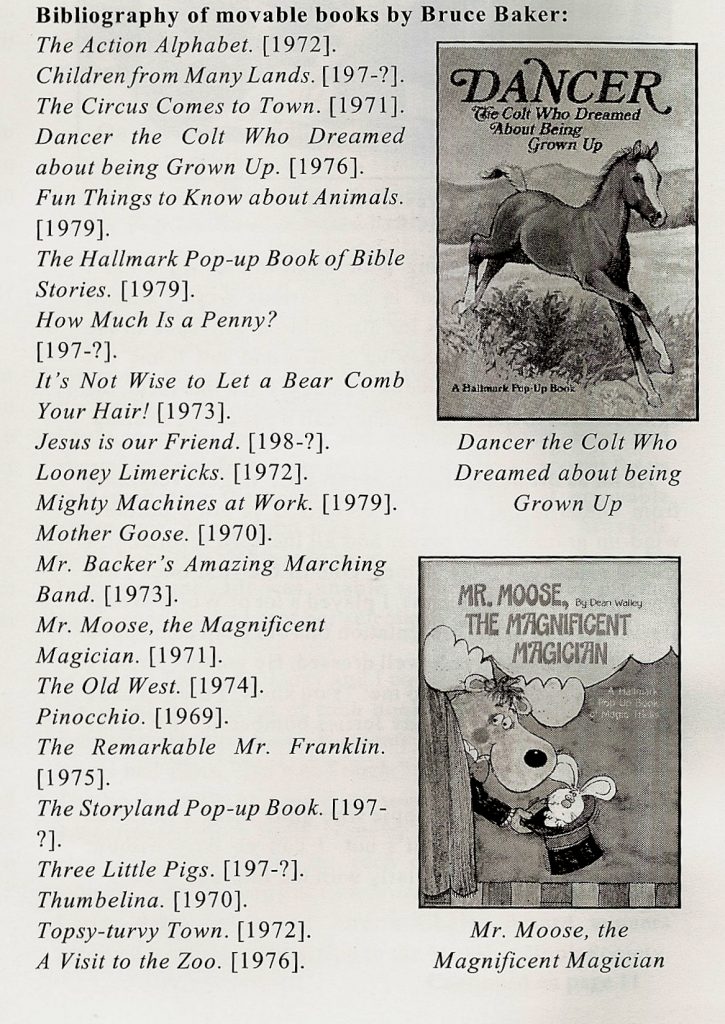
Barbara Valenta (1937 – 2003) Paper Engineer, Educator, Author
BARBARA VALENTA, 66, of Staten Island, N.Y., internationally renowned artist and committed teacher, died Aug. 1, 2003 at home. She created a legacy of imaginative, cutting-edge art works for which she received widespread critical acclaim. Born Barbara Simons in Manhattan, she moved to Larchmont, N.Y., as a child, and to Weston, Conn., in the early 1950s. She graduated from Sarah Lawrence College with a bachelor’s degree in liberal arts. She relocated to Los Alamos, N.M., in 1960 where she met her husband of 41 years, Milton Valenta. In 1967, she moved to Vienna, Austria, where her work was exhibited in several galleries and where she won first prize in an international sculpture competition honoring the 100th birthday of the automotive pioneer Ferdinand Porsche.
In 1978, she returned to Los Alamos, and in 1980 she had a one-woman show at the New Mexico Museum of Fine Arts in Santa Fe. She moved to Montclair, N.J., in 1981 and settled in Staten Island in 1984. She began her involvement with the city program “Studio in a School,” where she brought art classes to Latino students in East Harlem and to students on Staten Island. She also taught at the former Brooklyn campus of the Pratt Institute. She had a one-woman show at the Betty Parsons Gallery in Midtown Manhattan, as well as shows at the World Trade Center and the OK Harris gallery in the SoHo section of Manhattan. She was also praised as the author of the inventive book, “Pop-o-mania,” a children’s book on how to make pop-up books.
In addition to her husband, Milton, surviving are a daughter, Markha Valenta; a granddaughter, Elia; a stepmother, Alice Simons; brothers, Bill Simons and Issac Simons; and four sisters, Joan Constantikes, Edna Alvarez, Gail Humphreys and Brook Dougherty.
A memorial service was held at the Staten Island Children’s Museum at the Snug Harbor Cultural Center where she had hosted many craft workshops and which is also the site of her child-friendly interactive sculpture, “The Wagon.”
Historical Paper Engineers who left their mark!
The Life and Work of Lothar Meggendorfer -A biography from the University of Virginia
Home page for C. Carey Cloud [1899-1984], creator of movable Cracker Jackprizes and illustrator and paper engineer for some Blue Ribbon Books. So much more to learn about pop-ups and movables and this artist and inventor.
Ib Penick Paper Engineer Extraordinaire of the 2nd Golden Era
from The Chicago Tribune, April 24, 1998
Ib Penick, 67, Designer Of Modern Pop-up Books
By Meg McSherry Breslin
Ib Penick, the creative mind behind the resurgence of pop-up children’s books in the 1960s and ’70s and a man who devoted much of his life to helping thrill young readers across the country, died Tuesday of heart failure in his Wilmington, N.C., home. A former longtime resident of Chicago, he was 67.
Although pop-up books were popular during the 1920s and ’30s, they fell out of favor after World War II because they were easily damaged. But in the 1960s, Mr. Penick and his then-business partner Wally Hunt helped restore the books’ popularity through a full line of children’s titles for Random House that were visually exciting and more durable. The effort produced healthy profits for Random House and dozens of other publishers who followed. Today, many pop-up designers consider Mr. Penick the modern father of their industry and a key leader in the advancement of the worldwide development of pop-up books, greeting cards and advertisements. “He was really responsible for creating the whole world we lived in. With the advent of the Random House line, a whole industry was created and the very first ones were created by Ib,” said Gerald Harrison, the retired president of the children’s books division at Random House.
The first pop-up for Random House, published in 1967, was dubbed “Bennet Cerf’s Pop-Up Riddles.” It was followed by a long line of animal books, “Sesame Street” pop-ups, a Wonder Woman pop-up and many others tied to popular movies such as “Star Wars.” Mr. Penick worked with Jim Henson on one of his favorites, “The Muppet Show Pop-up Book.”
Mr. Penick was drawn to pop-ups after seeing older versions from the 1920s and ’30s, and becoming convinced he could improve them. “He was always looking for the next thrill,” said his longtime companion, Julia Rose. “And that’s sort of what he wanted his book or card to do–to thrill somebody and thrill them again and again.”
Mr. Penick came to the United States from Denmark in 1950 and held a series of odd jobs before settling into his first artistic position as a Yellow Pages advertising illustrator. He later opened an art studio in California, and it was there that Mr. Penick met Hunt, who had an ad agency and a large collection of pop-up books dating back to the 1920s. Once Mr. Penick studied the books, he was convinced that he could help revive a then-dead industry. Mr. Penick joined a company Mr. Hunt formed called Graphics International, the precursor to Hunt’s current firm, Intervisual Communications, now one of the world’s largest producers of pop-up books and advertisements.
“To be able to design something that would collapse and come up a thousand times without self-destructing takes genius. I invented the word `paper engineering,’ and that’s exactly what it is,” Hunt said. Mr. Penick’s genius wasn’t limited to his designs. Pop-up books must be assembled by hand, making mass production a potentially expensive enterprise. But Mr. Penick’s paper designs allowed the books and ads to be put together simply and economically.
While Mr. Penick was a household name in his industry, he never became a public figure. He married and divorced twice, and seldom settled in any place for too long. His stay in Chicago was his longest–a roughly 20-year residence in the city and northwest suburbs. In addition to his longtime companion, Mr. Penick is survived by a daughter, Kimberly McGee; two sons, Jason and Scott; a sister, Eva Mortensen; and three grandchildren. A private memorial service will be held in North Carolina.
John Strejan [1933-2003]-The Silverblade!
from the New York Times, April 17, 2003
John Strejan, Wizard of the Pop-Up Book, Dies at 70
By EDEN ROSS LIPSON
John Strejan, who earned the nickname Silverblade for his mastery of paper engineering in designing complicated and fanciful pop-up books for children and adults, died in Los Angeles on March 26. He was 70. The cause was cancer, said his daughter Stephanie Strejan-Schwartz. Mr. Strejan (the name is pronounced STREE-jen) was an artist from childhood, who discovered that he could figure out how things worked and then draw them with a knife. His nickname referred to his dazzling speed and skill with an X-Acto blade.
There are only a few dozen paper engineers in the world, all self-taught. It is hard not to marvel when a flat book opens and out comes a fully rigged galleon, a half-dozen dinosaurs or a breathing coral reef with eels swimming through the lacy boughs; pulling tabs can make shells open or tentacles wave.
But the exacting mechanics of how it is done are hard to explain. “I took paper, smashed it in a book and saw how it folded,” he once said of his early experiments. Complex constructions like Mr. Strejan’s, which must be assembled, slotted in, and glued by hand, contain hundreds of individual pieces of paper, each precisely cut to fit and fold exactly, and hundreds of glue points. Books with moveable parts can be traced to the 1300’s, but the 19th-century Germans Ernest Nister and Lothar Meggendorfer are credited with the modern form, which then languished until the 1960’s. Robert Sabuda, an author and illustrator of recent pop-up titles like “The 12 Days of Christmas: A Pop-Up Celebration,” called Mr. Strejan “a grand master of the generation when pop-up books entered their second golden age.” Mr. Sabuda said Mr. Strejan’s work “is so good that today I still can’t figure out how to do some of it.”
Mr. Strejan was born in Detroit and grew up in Portland, Ore. He moved to Los Angeles, where he worked for advertising agencies and was also art director for Teen magazine and Bullocks department store. His first three-dimensional projects were done for the Elgin Davis Art Studio. Mr. Davis was a founder of Graphics International, designers and producers of a new line of pop-books in the late 1960’s, which required hand assembly. It later became Intervisual Books , one of the leaders in the field today. Among the titles that established Mr. Strejan’s international reputation were the large-format collection “The Sailing Ships” (1984) and “The Facts of Life” (also 1984), by Dr. Jonathan Miller, an educational book for adults and children that was memorable for its inclusion of anatomically complete human genitalia; both were published by Viking.
From 1987 to 1989 Mr. Strejan engineered a National Geographic series on animals, including “Strange Animals of the Sea.” Mr. Strejan was married four times, most recently two days before he died to his companion of 17 years, Patricia Kroon. He is survived by four daughters from previous marriages, Ms. Strejan-Schwartz, Sabrina Sciacca, Heather Romano and Shannon Praytchl; two stepdaughters, Diane Umberger and Stacey Palmisano; a brother, Gene; and five grandchildren. In addition to creating more than 50 books, Mr. Strejan, who reveled in the freelance life, continued to do paper engineering for advertising displays like a pop-up version of the Magic Castle for Disney, a pop-up of the Getty Museum and posters for the movie “Toy Story.” Mr. Strejan’s last project for Intervisual Books, which sold about 500,000 copies in 13 countries, was “Choo-Choo Charlie: The Littletown Train” (1998; distributed in the United States by PiggyToes Press), a cardboard book and play set with a pop-up village and a wind-up train. And, it whistles.
It all begain [again] with Wally: RIP Wally Hunt
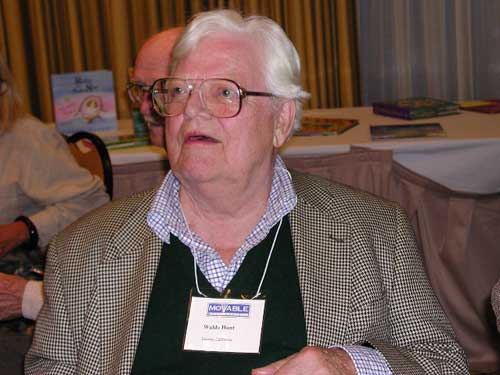
at the MBS Milwaukee Conference, 2002
from The Wall Street Journal November 24, 2009
The ‘King of the Pop-Ups’ Made Books Spring to Life
By STEPHEN MILLER
An impresario of printed extravaganzas, Waldo Hunt led a renaissance of pop-up books.
Mr. Hunt, who died Nov. 7 at age 88, was a one-time advertising executive who developed a specialty in creating pop-up magazine inserts. But what started as eye-catching marketing for Wrigley’s gum and Dodge pickup trucks grew into a literary subgenre.
Fascinated by what had become a lost art in the U.S. by the 1960s, Mr. Hunt built on his experience developing pop-up marketing materials into a focus on books. While not an artist himself, Mr. Hunt was adept at coordinating the complex process of assembling the books, from design to production and assembly. Leading publishing houses including Random House hired him to package pop-up titles for adults and children.
The companies he founded, Graphics International and Intervisual Books, produced hundreds of books, including some that were translated into more than a dozen languages. “King of the pop-ups” became Mr. Hunt’s moniker in professional circles.
Mr. Hunt produced dozens of books for Walt Disney; a series based on Babar; and popular titles including “Haunted House” and “The Human Body.” A 1967 pop-up published by Random House, “Andy Warhol’s Index,” came about at the suggestion of the artist. It combined celebrity photos with pop-up versions of signature Warhol touches like a cardboard can of tomato paste.
” He single-handedly kept the torch of pop-up books alive from the 1960s through the 1990s,” says Robert Sabuda, the best-selling creator of elaborate children’s pop-up books. “Those of us who are in the newer generation of pop-up books would have no career without Wally Hunt.”
Though pop-ups had flourished in Germany and Britain in the 19th century, and gained a following in the U.S. in the 1930s, they were little known in the post-World War II era.
” No one was doing pop-ups in this country,” Mr. Hunt told the Los Angeles Times in 2002. “No one could afford to make them here.”
Pop-up books allowed Mr. Hunt to combine his love of exuberant design with his overseas production contacts cultivated from his work in advertising. To save on labor costs, he had his early books assembled in Japan; production later moved to Singapore and to Latin America. Design was handled by a coterie of independent artists whom Mr. Hunt called “paper engineers” for their skill at unfurling three-dimensional figures from flat paper.
The son of a Unitarian minister and a music teacher, Mr. Hunt grew up in Salt Lake City and southern California, and served in the infantry during World War II.
After the war, he opened an advertising agency in Los Angeles, specializing in high-quality printed materials. He sold his first agency in 1956, and founded Graphics International Inc., to serve as a broker between Japanese printers and U.S. clients.
video
Mr. Hunt described his infatuation with pop-up books as a bolt from the blue. One day in the early 1960s while walking down New York’s Fifth Avenue, he spotted a pop-up book in a shop window.
” I could look at that children’s book from Czechoslovakia and see in it my answer,” Mr. Hunt told the Los Angeles Times. “I knew I’d found the magic key.”
After his bid to import a large number books by the book’s Czech artist, Vojtěch Kubašta, was thwarted by Communist authorities, Mr. Hunt turned to producing them himself. The first was a promotional volume produced in conjunction with Random House for Maxwell House Coffee, “Bennett Cerf’s Pop-Up Riddle Book,” which customers could receive by sending in two can labels and $1.
Bennett Cerf, Random House’s top editor, put his son Christopher in charge of the project.
” You’d pull a tab and something funny would happen, and the answer to the riddle would be revealed,” Christopher Cerf recalled in an interview. The younger Mr. Cerf and Mr. Hunt went on to produce about 30 more children’s pop-up books for Random House, including volumes featuring Sesame Street characters. In his memoir “At Random,” Bennett Cerf described the pop-up books as big money makers.
Mr. Hunt “was a joyful man,” says Christopher Cerf. “Sometimes to his own detriment, he took on huge, crazy projects. Nothing was impossible.”

